Zoom
Trash

Travel Inside 3D Cells in Full Color on Your Laptop. March 7, 2015 (Nanowerk News) Nanolive SA announces the release of an off-line version of STEVE.

“Starting from today, scientists, Medical Doctors and students all around the world will be enabled to travel inside 3D cells in full color by simply downloading STEVE on their laptop” declares Dr. Yann Cotte, CEO and co-founder of Nanolive SA.Nanolive SA is a Swiss start-up company, based at Innovation Park in Lausanne, which is developing a revolutionary microscope (and a revolutionary software) able to image and digitally stain living cells in 3D without any sample preparation and in real-time.
The company, which has already received more than 45 pre-orders (with partial up-front payments), is planning the market entry for this summer.STEVEThe value measured by the 3D Cell Explorer is not fluorescence intensity of an exogenous molecule like with most optical microscopes. Changes to digital stains are shown in real time in both 2D and 3D views. BioNumbers - The Database of Useful Biological Numbers. Cell biology by the numbers. Researchers show that memories reside in specific brain cells. Our fond or fearful memories — that first kiss or a bump in the night — leave memory traces that we may conjure up in the remembrance of things past, complete with time, place and all the sensations of the experience.
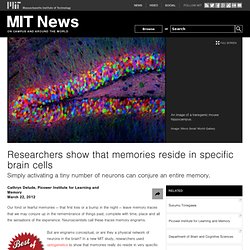
Neuroscientists call these traces memory engrams. But are engrams conceptual, or are they a physical network of neurons in the brain? In a new MIT study, researchers used optogenetics to show that memories really do reside in very specific brain cells, and that simply activating a tiny fraction of brain cells can recall an entire memory — explaining, for example, how Marcel Proust could recapitulate his childhood from the aroma of a once-beloved madeleine cookie.
Animal-cell-label.jpg. Cell. In biology, the cell is the basic structure of organisms.
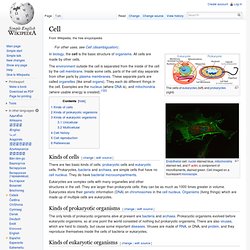
All cells are made by other cells. Kinds of cells[change | edit source] There are two basic kinds of cells: prokaryotic cells and eukaryotic cells. Prokaryotes, bacteria and archaea, are simple cells that have no cell nucleus. They do have bacterial microcompartments. Eukaryotes are complex cells with many organelles and other structures in the cell. Category:Cells. Catégorie:Cellule. 4. The Cell: Down to Basics [Beyond Books - Life Science: Part 1] What do a two-foot-long neuron, a two pound ostrich egg, and .2-micrometer-long bacteria all have in common?
![4. The Cell: Down to Basics [Beyond Books - Life Science: Part 1]](http://cdn.pearltrees.com/s/pic/th/basics-beyond-books-science-18041328)
Each is a single cell. Cells are the basic unit of structure and function in living things, the smallest things that can perform all of the functions of life. Aside from the occasional ostrich egg or nerve cell, most cells are very small and can't be seen without magnification. As a result, our knowledge of cells has grown as technology has allowed us to see them. The art of glassmaking in the 1600s led to the creation of the first simple microscope lenses, making it possible to see cells up close and personal for the first time.
Cell biology. Understanding cells in terms of their molecular components.
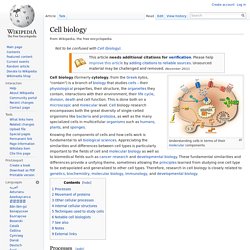
Knowing the components of cells and how cells work is fundamental to all biological sciences. Appreciating the similarities and differences between cell types is particularly important to the fields of cell and molecular biology as well as to biomedical fields such as cancer research and developmental biology. These fundamental similarities and differences provide a unifying theme, sometimes allowing the principles learned from studying one cell type to be extrapolated and generalized to other cell types. Cell (biology) Cellule (biologie) Un article de Wikipédia, l'encyclopédie libre.
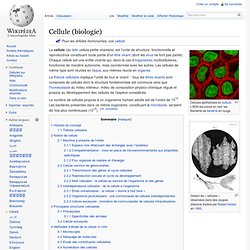
Pour les articles homonymes, voir cellule. Cellules épithéliales en culture. Category:Cell biology. Catégorie:Biologie cellulaire. Learn Science at Scitable. Cell biology is the study of cell structure and function, and it revolves around the concept that the cell is the fundamental unit of life.
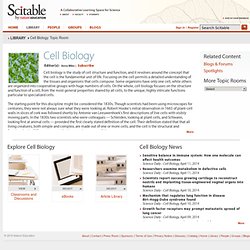
Focusing on the cell permits a detailed understanding of the tissues and organisms that cells compose. Some organisms have only one cell, while others are organized into cooperative groups with huge numbers of cells. On the whole, cell biology focuses on the structure and function of a cell, from the most general properties shared by all cells, to the unique, highly intricate functions particular to specialized cells. The starting point for this discipline might be considered the 1830s. Though scientists had been using microscopes for centuries, they were not always sure what they were looking at. As microscopes and staining techniques improved over the nineteenth and twentieth centuries, scientists were able to see more and more internal detail within cells. Molecular & Cell Biology For Dummies Cheat Sheet. Cheat Sheet Studying molecular and cell biology can be challenging, but it's necessary if you want to pursue microbiology, biotechnology, or genetics.

Understanding molecular and cell biology entails knowing the four groups of macromolecules; the processes of central dogma and cellular respiration; and essential components of eukaryotic cells. Portail:Biologie cellulaire et moléculaire/Explorer. Dramatic diagrams of cell biology and atomic structure belong in a beautiful textbook. Discovery of Cells. Mitochondria. 'Moonlighting' Molecules Discovered; Researchers Uncover New Kink In Gene Control.
Since the completion of the human genome sequence, a question has baffled researchers studying gene control: How is it that humans, being far more complex than the lowly yeast, do not proportionally contain in our genome significantly more gene-control proteins?

Now, a collaborative effort at the Johns Hopkins School of Medicine to examine protein-DNA interactions across the whole genome has uncovered more than 300 proteins that appear to control genes, a newly discovered function for all of these proteins previously known to play other roles in cells. The results, which appear in the October 30 issue of Cell, provide a partial explanation for human complexity over yeast but also throw a curve ball in what we previously understood about protein functions. The team set out to figure out which proteins encoded by the genome bind to which DNA sequences.
One at a time, the team tested each of the 460 DNA sequences against the 4,200 protein-containing chip. Brain & Nervous Systems. Scientists recreate brain cell networks providing view of activity behind memory formation. Backwards signals appear to sensitize brain cells, rat study shows. Monday, March 18, 2013 During waking hours, electrical signals travel from dendrites—antenna-like projections at one end of the cell-- through the cell body.

From the cell body, they then travel the length of the axon, a single long projection at the other end of the cell. This electrical signal stimulates the release of chemicals at the end of the axon, which bind to dendrites on adjacent cells, stimulating these recipient cells to fire electrical signals, and so on. When groups of cells repeatedly fire in this way, the electrical signals increase in intensity. Dr. Researchers show that memories reside in specific brain cells. Bio-informatique. Un article de Wikipédia, l'encyclopédie libre. La bioinformatique est un champ de recherche multi-disciplinaire où travaillent de concert biologistes, médecins, informaticiens, mathématiciens, physiciens et bioinformaticiens, dans le but de résoudre un problème scientifique posé par la biologie.
Depuis quelques années les progrès de l'informatique (et en particulier de la bioinformatique mise au service de la biodiversité ou « Biodiversity informatics » pour les anglophones) dopent la biologie évolutive en offrant aux chercheurs un accès à un nombre croisant de données sur la diversité et les variation des gènes, ainsi que des génomes, des organismes et de l'environnement en général. Tout cela peut être relié à la phylogénie (de l'étude des populations à celle de clades entiers), via de nouveaux protocoles et réseaux dans le domaine de l'informatique de la biodiversité. Learn.Genetics™ DNA from the Beginning - An animated primer of 75 experiments that made modern genetics. Peut-on concevoir la cellule comme un ordinateur qui ferait des ordinateurs ? - Antoine Danchin.
Bioengineers Build Open Source Language for Programming Cells. Drew Endy wants to build a programming language for the body. Endy is the co-director of the International Open Facility Advancing Biotechnology — BIOFAB, for short — where he’s part of a team that’s developing a language that will use genetic data to actually program biological cells. That may seem like the stuff of science fiction, but the project is already underway, and the team intends to open source the language, so that other scientists can use it and modify it and perfect it.
The effort is part of a sweeping movement to grab hold of our genetic data and directly improve the way our bodies behave — a process known as bioengineering. With the Supreme Court exploring whether genes can be patented, the bioengineering world is at crossroads, but scientists like Endy continue to push this technology forward. According to Ziv Bar-Joseph, a computational biologist at Carnegie Mellon University, gene expression isn’t that different from the way computing systems talk to each other. Définition Bio-informatique - Encyclopédie scientifique en ligne. On regroupe sous le terme de bioinformatique un champ de recherche multi-disciplinaire où travaillent de concert biologistes, informaticiens, mathématiciens et physiciens, dans le but de résoudre un problème scientifique posé par la biologie. D'après Claverie : La bioinformatique est constituée par l'ensemble (En théorie des ensembles, un ensemble désigne intuitivement une collection d’objets (les éléments de l'ensemble), « une...) des concepts et des techniques nécessaires à l'interprétation de l'information génétique (La génétique (du grec genno γεννώ = donner naissance) est la science qui étudie l'hérédité et les...)
(séquences) et structurale (repliement 3D). Hybrid digital/analog processor pursues machine vision apps. - Research Group ANPRON.